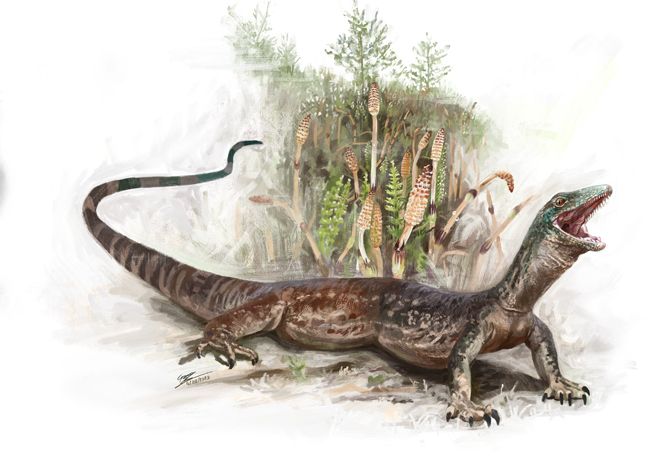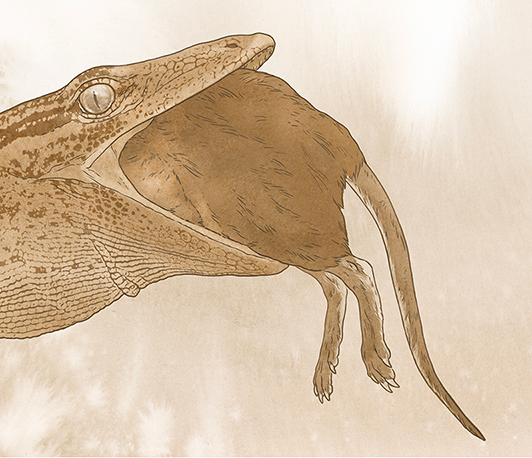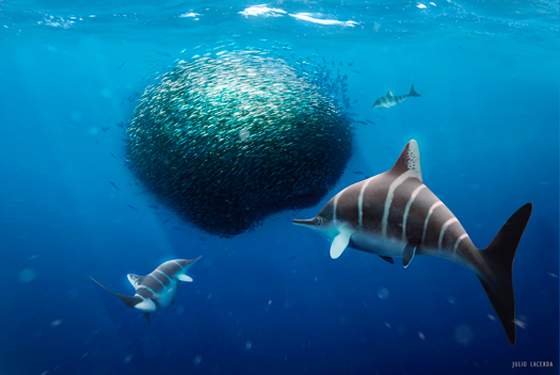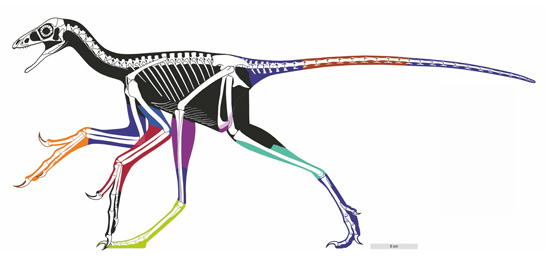A fossil discovery made on the Isle of Skye reveals clues to the origins of modern snakes and lizards. The animal, named Breugnathair elgolensis, lived during the Bathonian stage of the Middle Jurassic. The fragmentary and disarticulated fossils are approximately 167 million years old. The scientific paper has been published in the journal “Nature”.

Breugnathair elgolensis life reconstruction. Picture credit: Brennan Stokkermans (National Museums of Scotland).
Picture credit: Brennan Stokkermans (National Museums of Scotland)
Meet Breugnathair elgolensis
This reptile had the proportions and limbs of a lizard. However, its jaws, lined with highly recurved teeth, were similar to the jaws of extant pythons. The fossil specimen represents one of the oldest and most complete Jurassic lizards discovered to date. It has been classified as a member of the Squamata order. The squamates include lizards and snakes. The evolutionary origins of the Squamata remain open to debate. Although, many palaeontologists consider that the first squamates evolved in the Early Jurassic around 190 million years ago.
The fossil was discovered near Elgol by Dr Stig Walsh (National Museums Scotland). This rare fossil is now part of the Museum’s vertebrate fossil collection.
Picture credit: Duncan McGlynn
The fossil material and others like it will help palaeontologists to better understand the evolution of snakes and lizards. For example, are snakes are early off-shoot from the lizard lineage or did snake-like characteristics evolve more than once in the Squamata?
The “False Snake of Elgol”
The fossils are exposed on a single limestone slab. The material includes caudal vertebrae, limb bones, ribs as well as bones from the skull. The scientific name is taken from Gaelic. It translates as “false snake of Elgol”. It has been placed in a newly created family, the Parviraptoridae. Until now, parviraptorids were known only from fragmentary remains. Some scientists thought they might represent basal snakes. In contrast, other scientists have proposed that parviraptorids were ancestors of all snakes and lizards.

An illustration of Breugnathair elgolensis swallowing a mammaliaform. We suspect that the unfortunate victim is the mammaliaform Krusatodon kirtlingtonensis, fossils of which are also known from the Isle of Skye. Picture credit: Mick Ellison (American Museum of Natural History).
Picture credit: Mick Ellison (American Museum of Natural History)
The illustration (above) depicts a Breugnathair swallowing an early mammaliaform. The artist could be suggesting that Breugnathair is feeding on a Krusatodon (K. kirtlingtonensis). There have been many remarkable fossil discoveries made on the Isle of Skye. The exposed strata were laid down in the Middle Jurassic. Fossiliferous deposits from this time in Earth’s history are rare.
An article about Krusatodon fossils from the Isle of Skye: Providing an Insight into Mammaliaform Ontogeny.
To read an article about a large pterosaur fossil discovered on the Isle of Skye (Dearc sgiathanach): Fantastic Pterosaur Fossil from the Isle of Skye.
A Window into Evolution
Breugnathair elgolensis fossil material reveals a mosaic of primitive and more derived features. This mosaic of advanced traits combined with more primitive characteristics is found in other parviraptorids. The path taken by evolution is unpredictable.
Picture credit: Duncan McGlynn
Mike from Everything Dinosaur commented:
“The Isle of Skye is recognised as one of the world’s most important Middle Jurassic fossil locations. Other discoveries include Scotland’s most complete dinosaur, ancient synapsids, and even flying reptiles. Breugnathair demonstrates the diverse palaeoenvironment represented by these deposits.”
Everything Dinosaur acknowledges the assistance of a media release from National Museums Scotland in the compilation of this article.
The scientific paper: “Mosaic anatomy in an early fossil squamate” by Roger B. J. Benson, Stig A. Walsh, Elizabeth F. Griffiths, Zoe T. Kulik, Jennifer Botha, Vincent Fernandez, Jason J. Head and Susan E. Evans published in the journal Nature.
The award-winning Everything Dinosaur website: Prehistoric Animal Models and Figures.






Leave A Comment